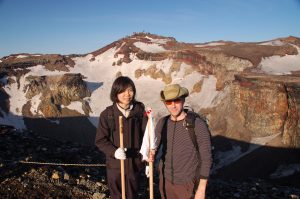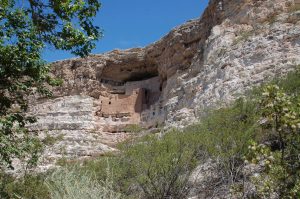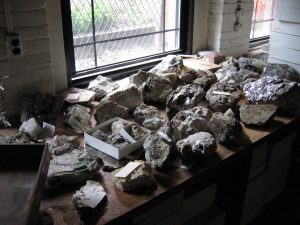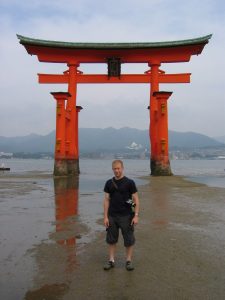Robert Libutti – 2002
 Robert Libutti 2002
Robert Libutti 2002
When I was younger, we often traveled to a variety of National Parks for family vacations. At the time, I didn’t always appreciate the trips to Yellowstone, Glacier, Canyon Lands and others. But it’s impossible to imagine that they weren’t critical in forming my interest in the natural sciences. I was always drawn toward science, particularly earth science, but it was in my senior year of high school when a great course in ecology sealed the deal. I entered Lafayette as a declared geology major and never regretted it.

Lafayette affords students all of the opportunities of a large university; the range of classes, the resources and facilities, and the exceptional faculty. But also, the small size allows you the chance to form relationships with professors, an experience that I have found rare among peers at other schools. I remain in touch with professors not only from the geology department, but from the anthropology department as well. While at Lafayette, I participated in the EXCEL Program with Guy Hovis and TA’d various classes. In addition to taking almost every course offered by the geology department, I had the freedom to take classes in business, anthropology, art, and music, organize two hardcore metal music festivals, and host a radio show.
 After graduation from Lafayette, I moved to Cambridge Massachusetts where I worked in the Harvard Museum of Natural History as a Curatorial Assistant in the Mineralogical Museum. Working at Harvard was an incredible experience where I was able to see and work with world class mineral specimens on a daily basis. I assisted with organizing the mineral collection, preparing exhibits featuring multi-million dollar, one of a kind gold specimens, identifying samples using an Xray diffractometer (the same instrument we used in Van Wickle), and providing samples to NASA for use as standards for Mars research.
After graduation from Lafayette, I moved to Cambridge Massachusetts where I worked in the Harvard Museum of Natural History as a Curatorial Assistant in the Mineralogical Museum. Working at Harvard was an incredible experience where I was able to see and work with world class mineral specimens on a daily basis. I assisted with organizing the mineral collection, preparing exhibits featuring multi-million dollar, one of a kind gold specimens, identifying samples using an Xray diffractometer (the same instrument we used in Van Wickle), and providing samples to NASA for use as standards for Mars research.
It was while working at Harvard that I took a summer course at the School of Design to explore my budding interest in architecture. From there, I began the application process in pursuit of a Master of Architecture degree at the University of Pennsylvania. I often get asked, “How did you go from geology to architecture?” Dru Germanoski always talked about geology being a systems approach, and that was the tie between geology and architecture. Each piece of a building informs another. The thought process learned studying geology lead to architecture. The technical training of the geology curriculum gave me a beneficial edge in my required building systems and structural design courses, allowing me to focus on my design courses. Although, architects’ insistence on calling all natural stone either slate, granite, or marble is nails on a chalk board. Stop! Can’t you see there’s too much feldspar?!
 During my time at Penn, I was fortunate enough to participate in a summer course in Japan, then returned to Osaka the next summer for an internship at Takenaka Corporation, and then moved to Tokyo upon graduation where I worked at Jun Mitsui and Associates for a year. Japan’s seismic conditions and climate proved to be an interesting intersection between geology and architecture. The capstone to my time in Japan was seeing the sun rise from the peak of Mt. Fuji. Upon my return to the States, I became a LEED Accredited Professional (Leadership in Energy and Environmental Design). After two years working in Manhattan, I returned to Pennsylvania where I have been working at Kautter & Kelley Architects on a variety of projects for the past four years. It wasn’t until leaving NYC that I was given the freedom and time to form a band, develop a board game, and travel extensively to Italy, Germany, Czech Republic, Austria, and Hungary.
During my time at Penn, I was fortunate enough to participate in a summer course in Japan, then returned to Osaka the next summer for an internship at Takenaka Corporation, and then moved to Tokyo upon graduation where I worked at Jun Mitsui and Associates for a year. Japan’s seismic conditions and climate proved to be an interesting intersection between geology and architecture. The capstone to my time in Japan was seeing the sun rise from the peak of Mt. Fuji. Upon my return to the States, I became a LEED Accredited Professional (Leadership in Energy and Environmental Design). After two years working in Manhattan, I returned to Pennsylvania where I have been working at Kautter & Kelley Architects on a variety of projects for the past four years. It wasn’t until leaving NYC that I was given the freedom and time to form a band, develop a board game, and travel extensively to Italy, Germany, Czech Republic, Austria, and Hungary.
From analyzing rubidium feldspar, to moving to Boston, changing gears from geology to architecture, to living in a 200 square foot apartment in Tokyo, the past 15 years have been a steady stream of unique opportunities. Starting at Lafayette through today, saying “yes” to those opportunities has written a story that I would have never imagined sitting in Van Wickle as a freshman. Say yes, try new things, work to expand your comfort zone. It’s not always easy, things don’t always work out, and maybe you won’t achieve all of your goals, but chances are, there’s a pretty cool story in there.